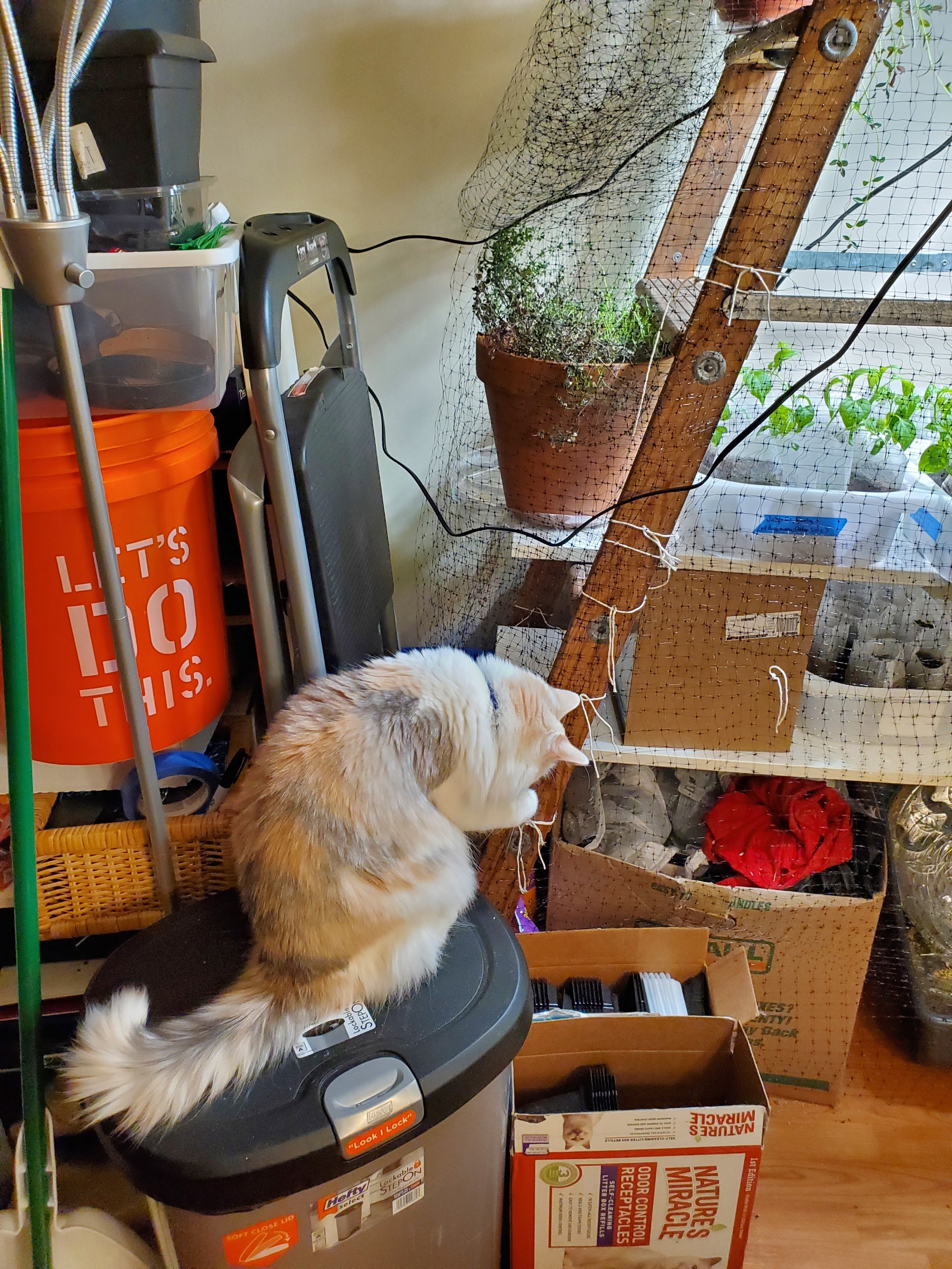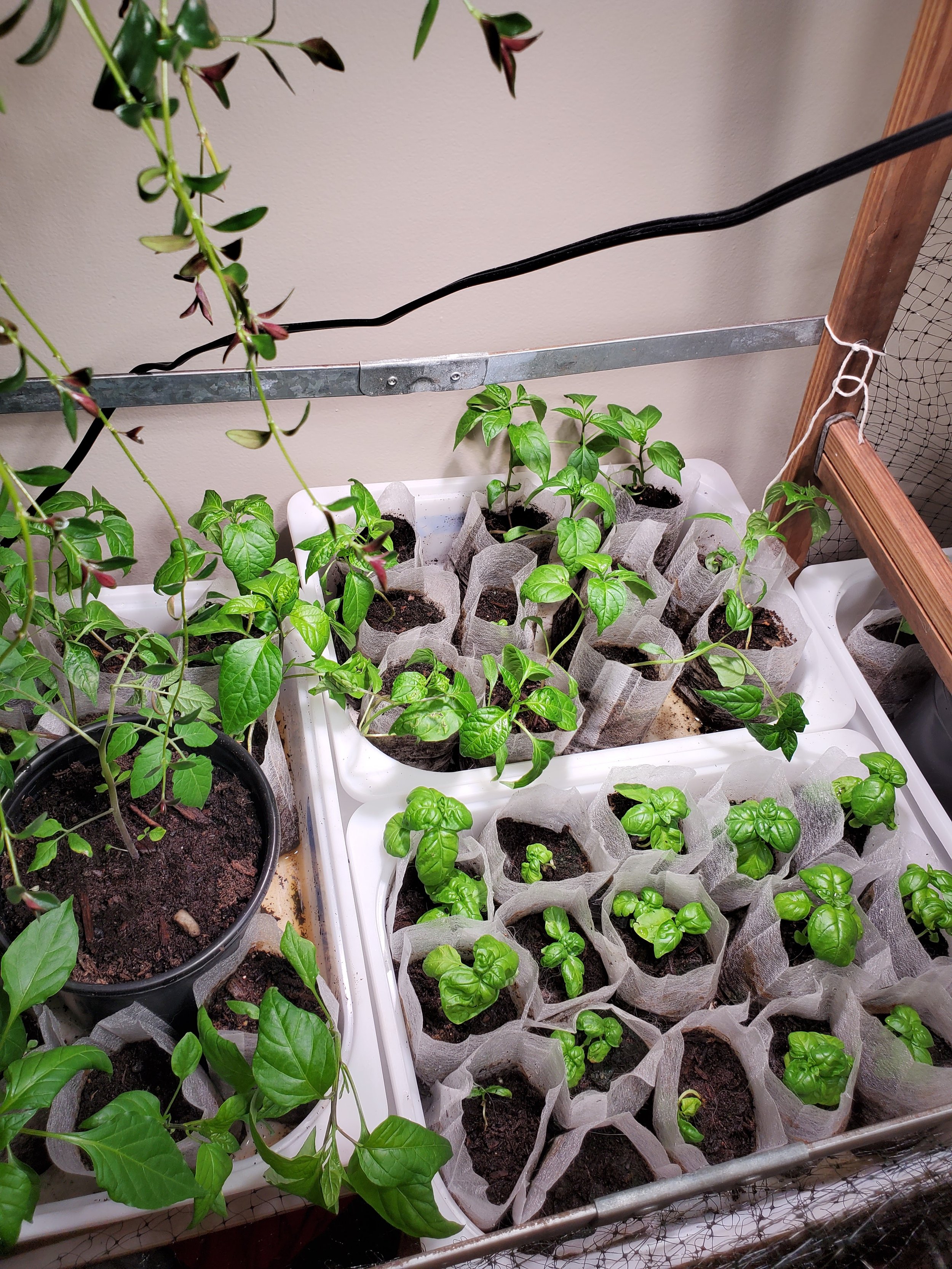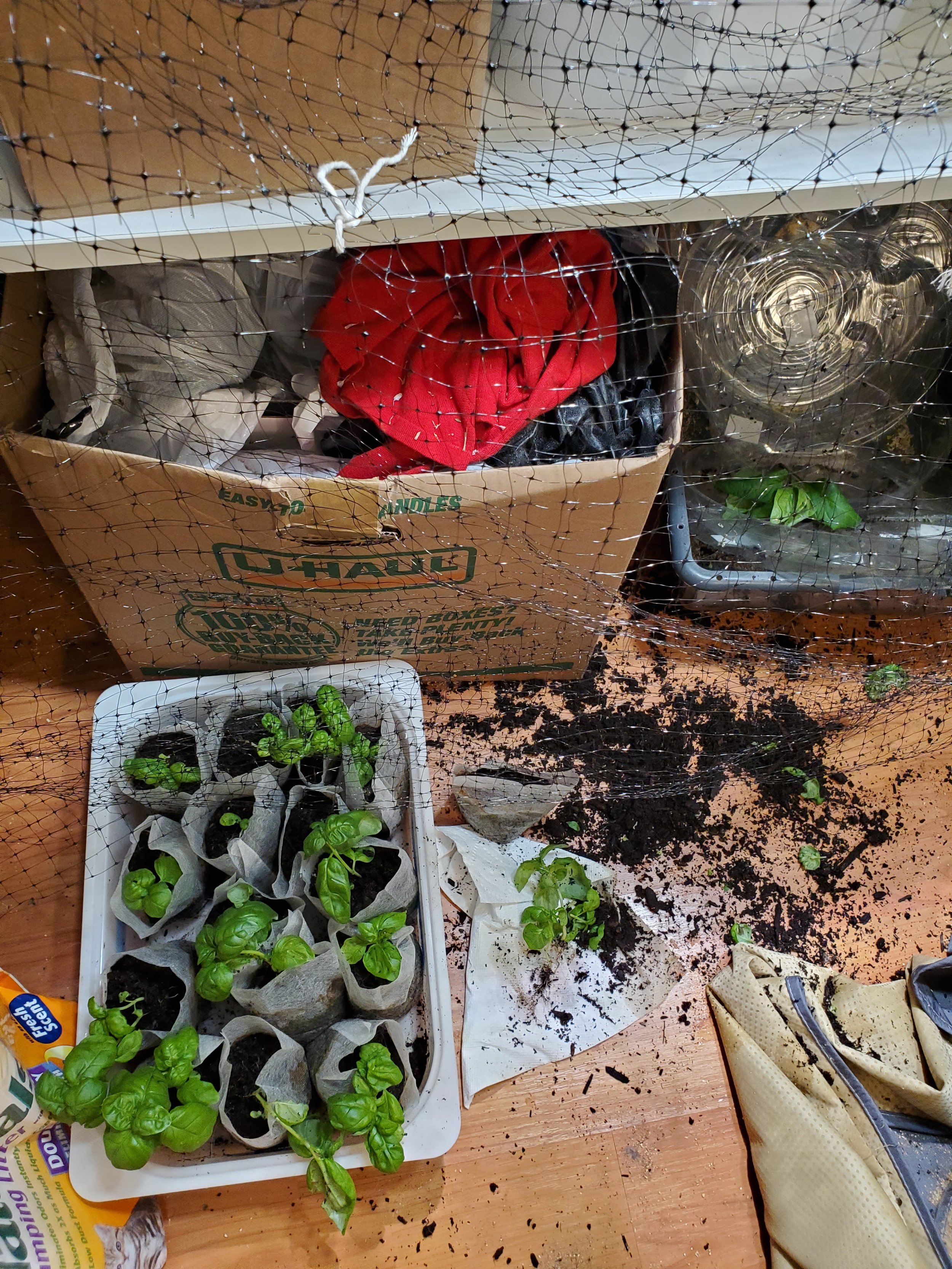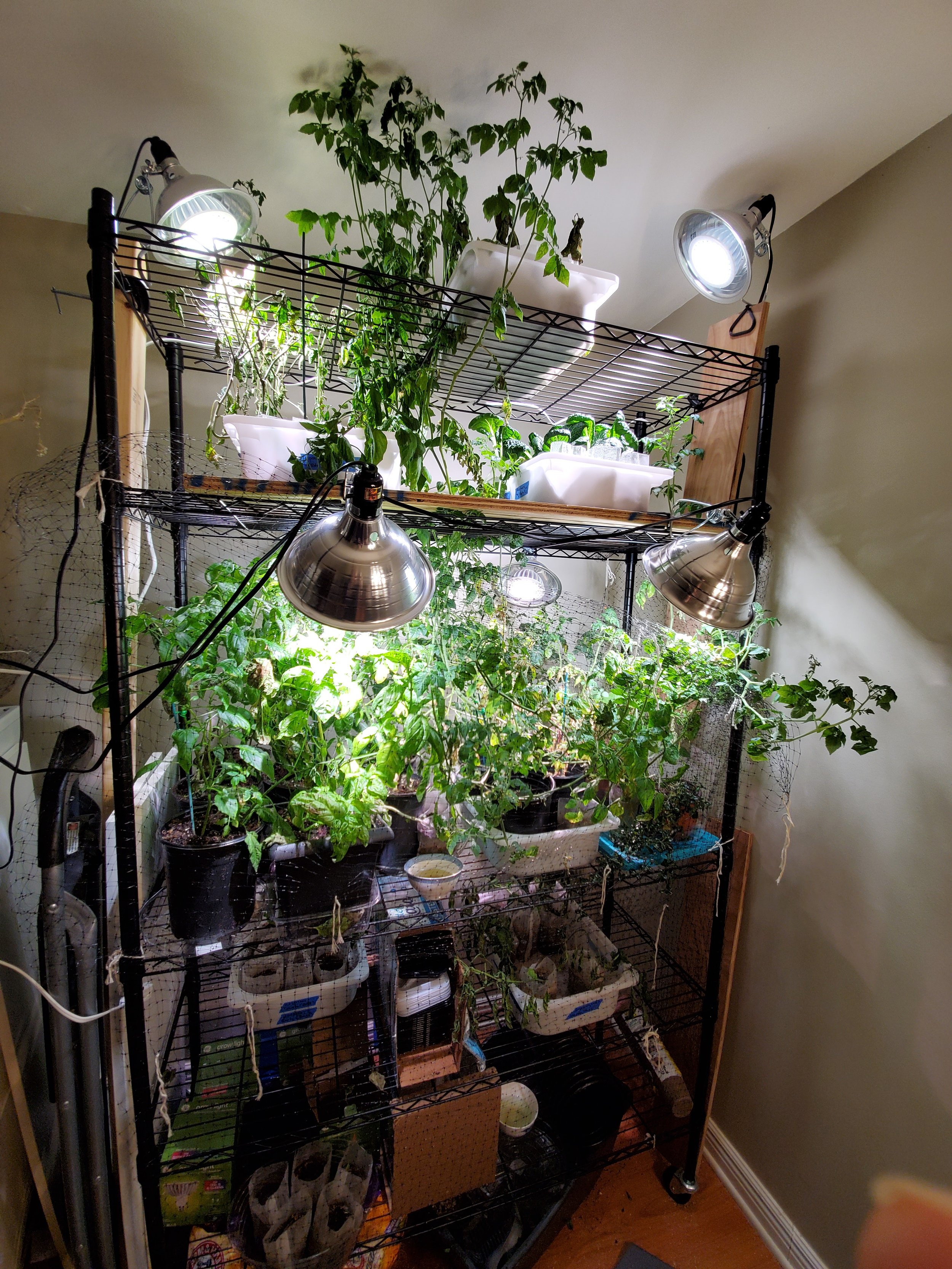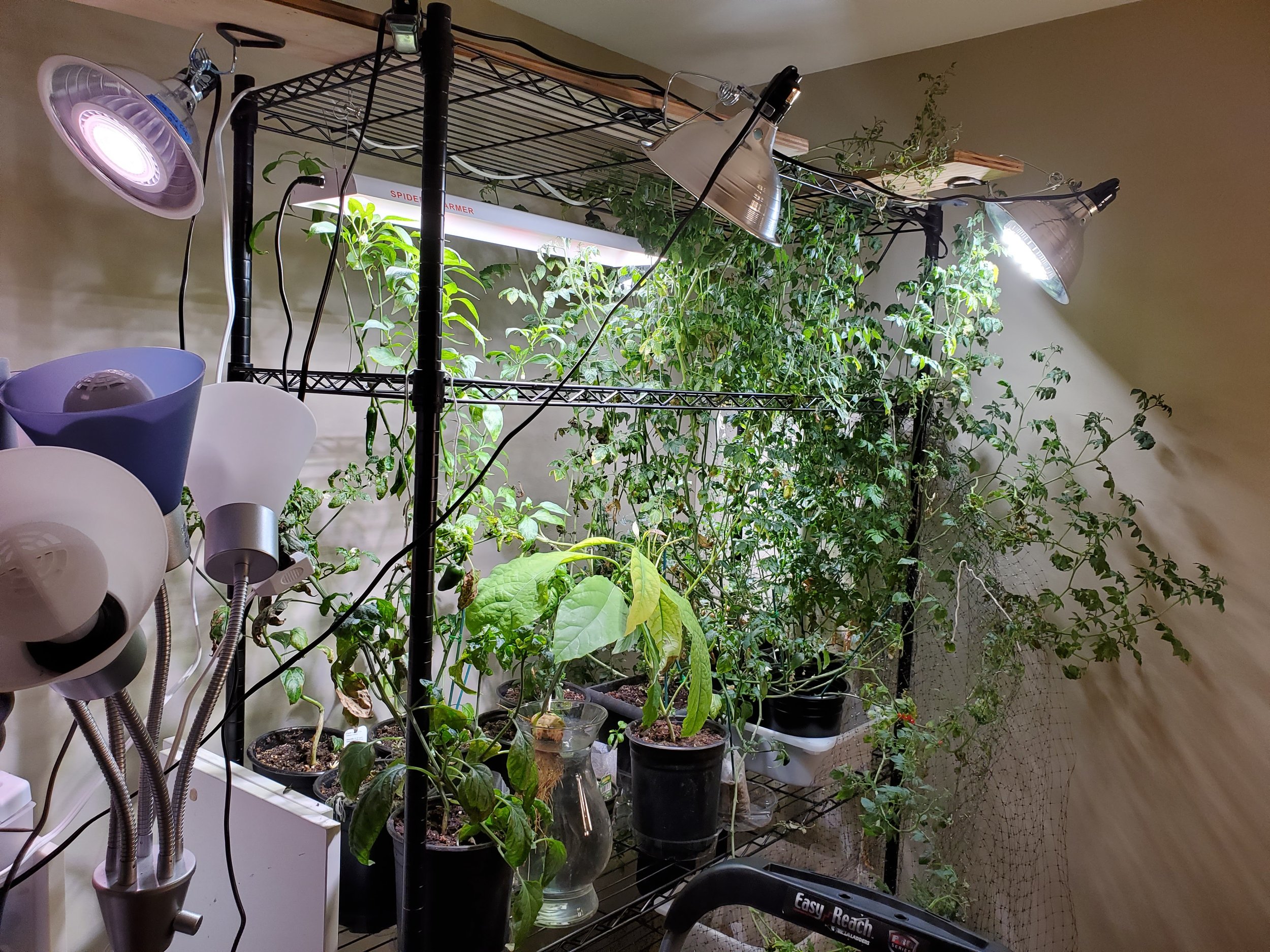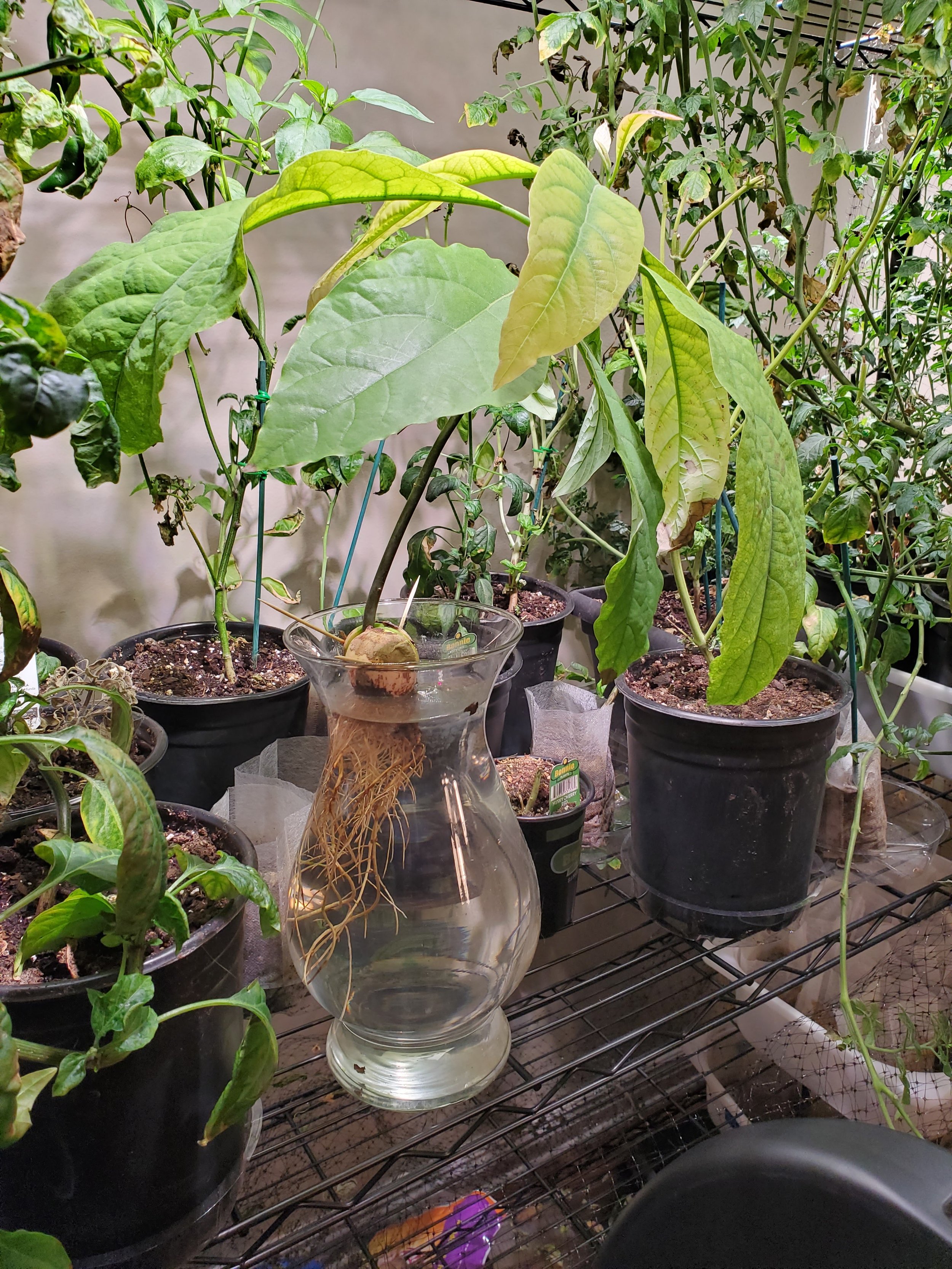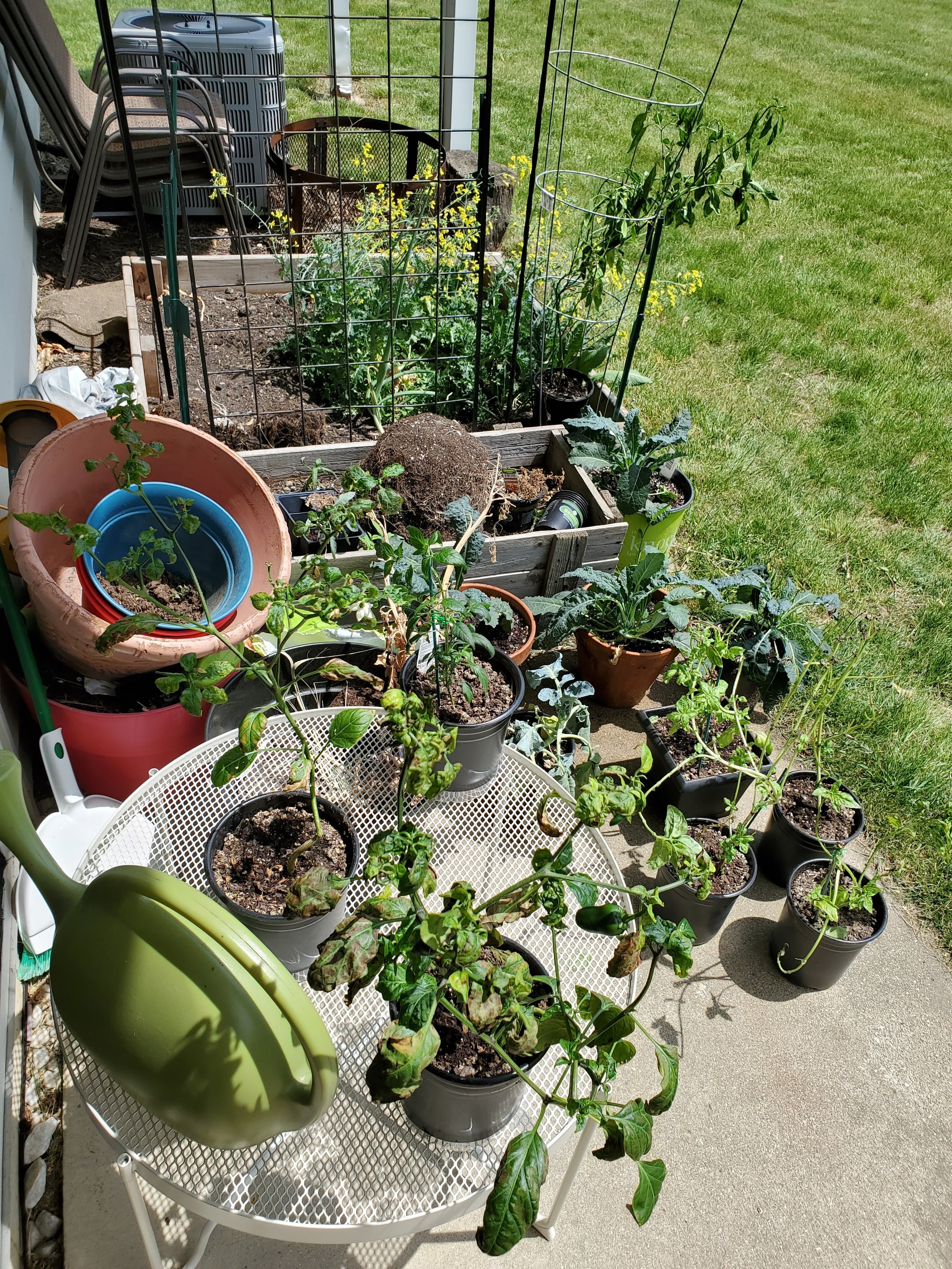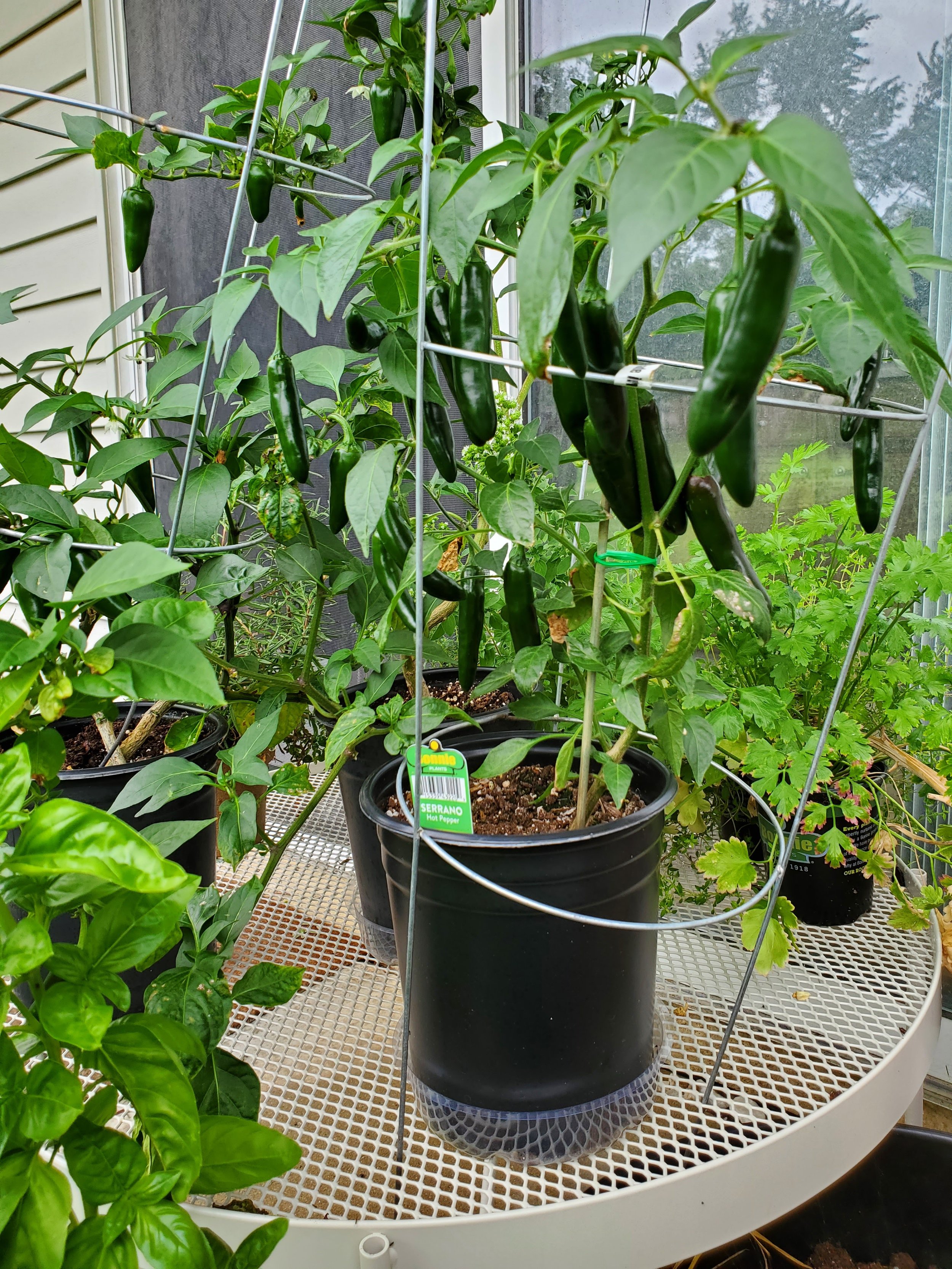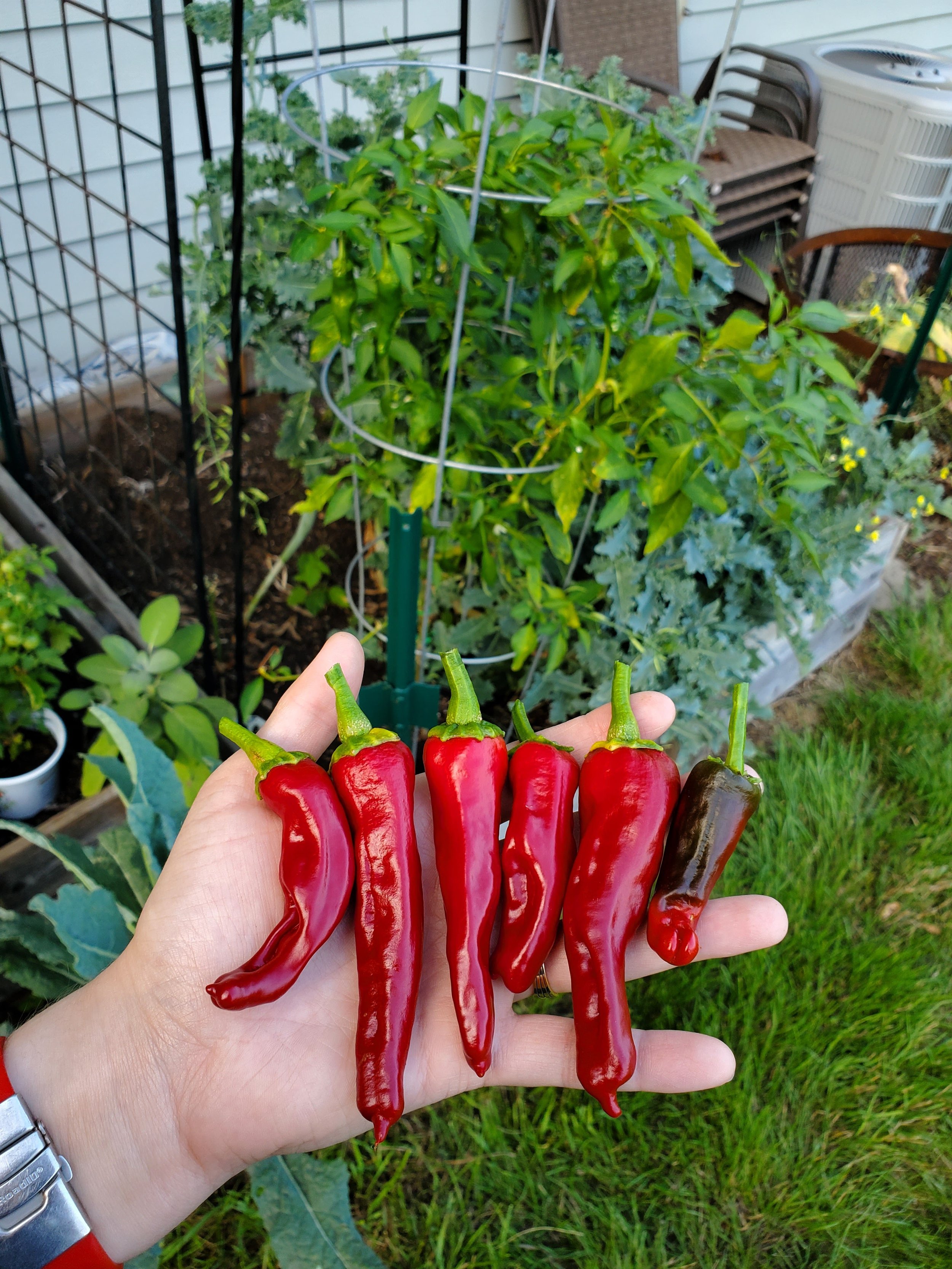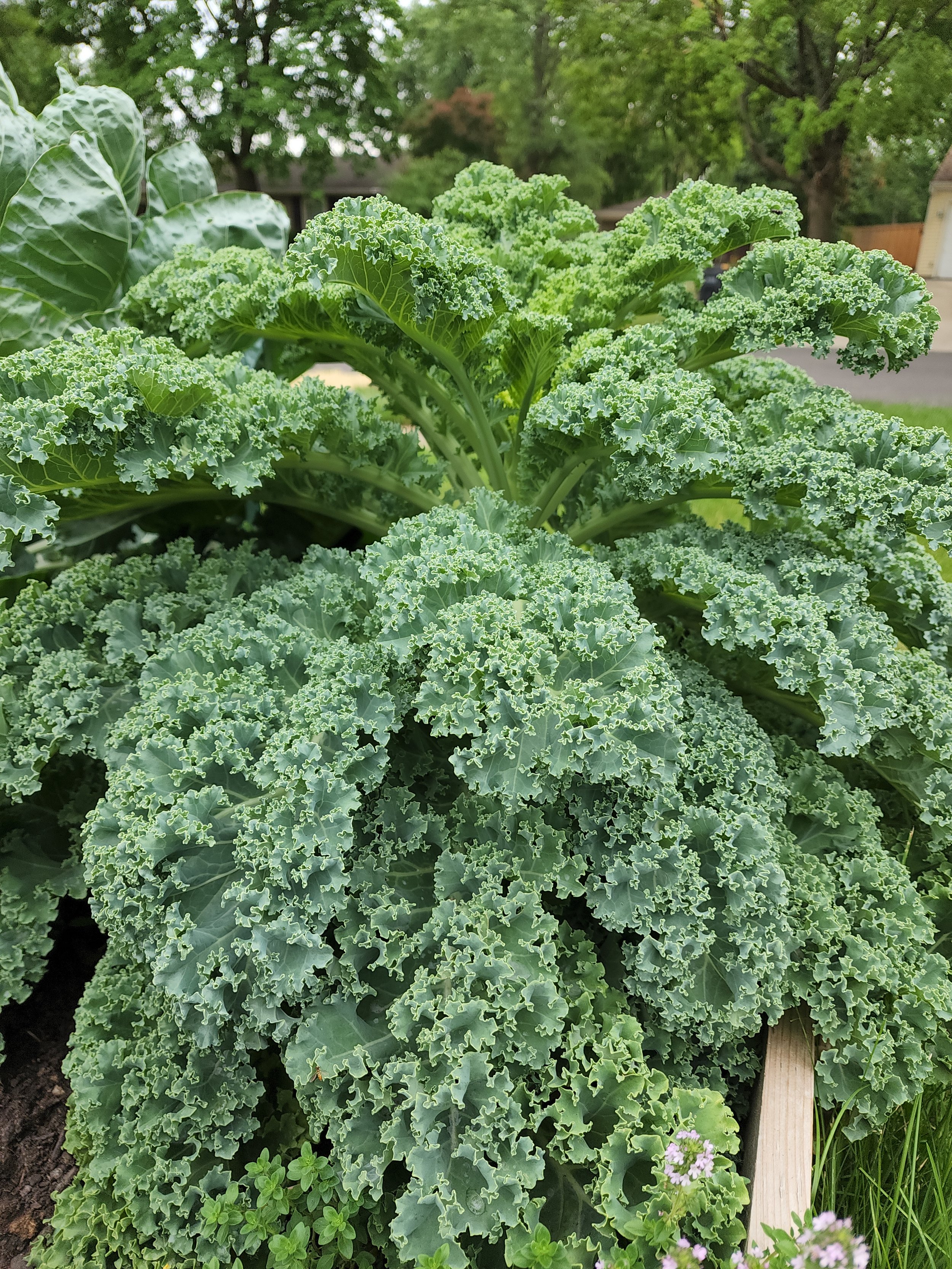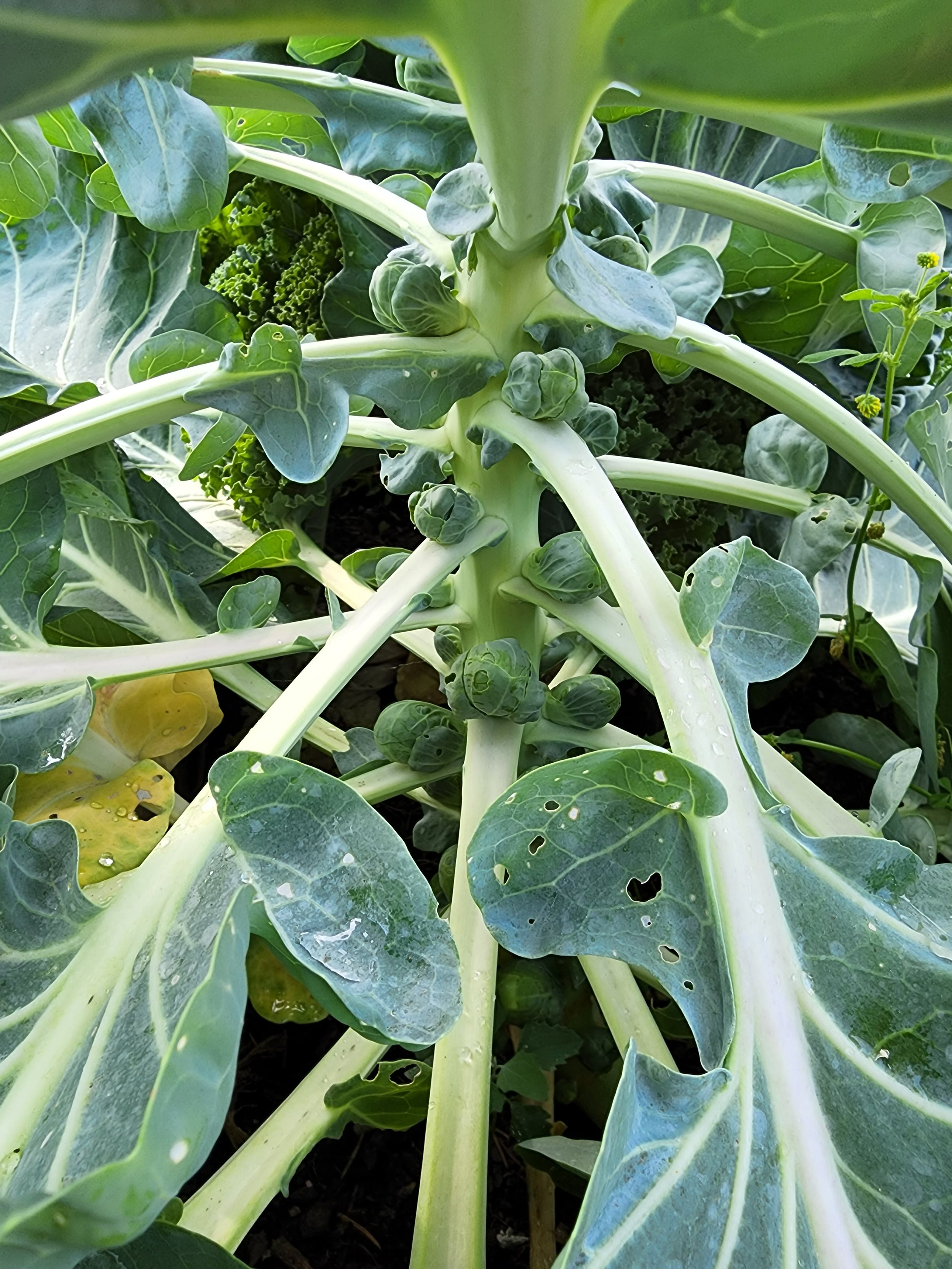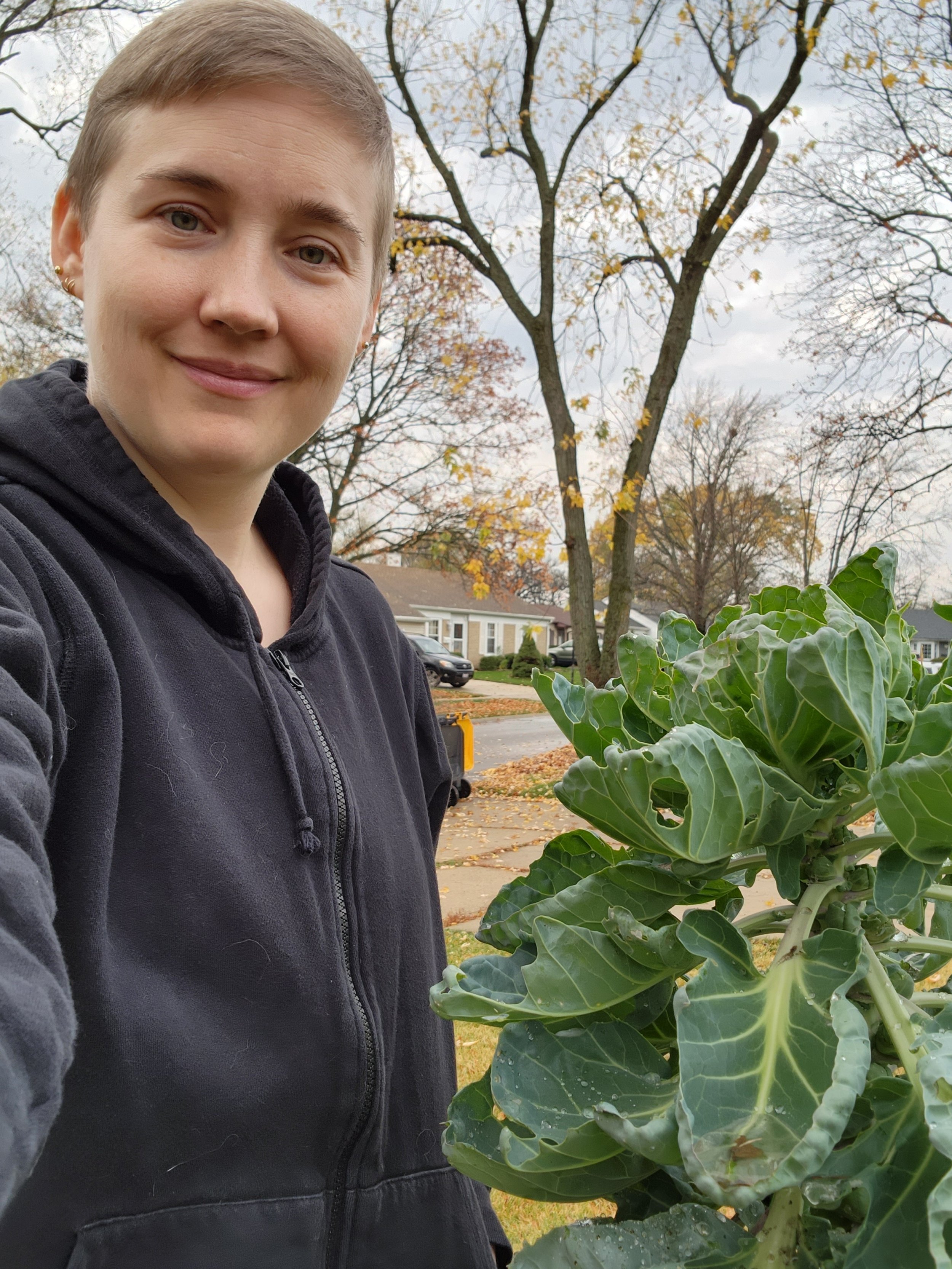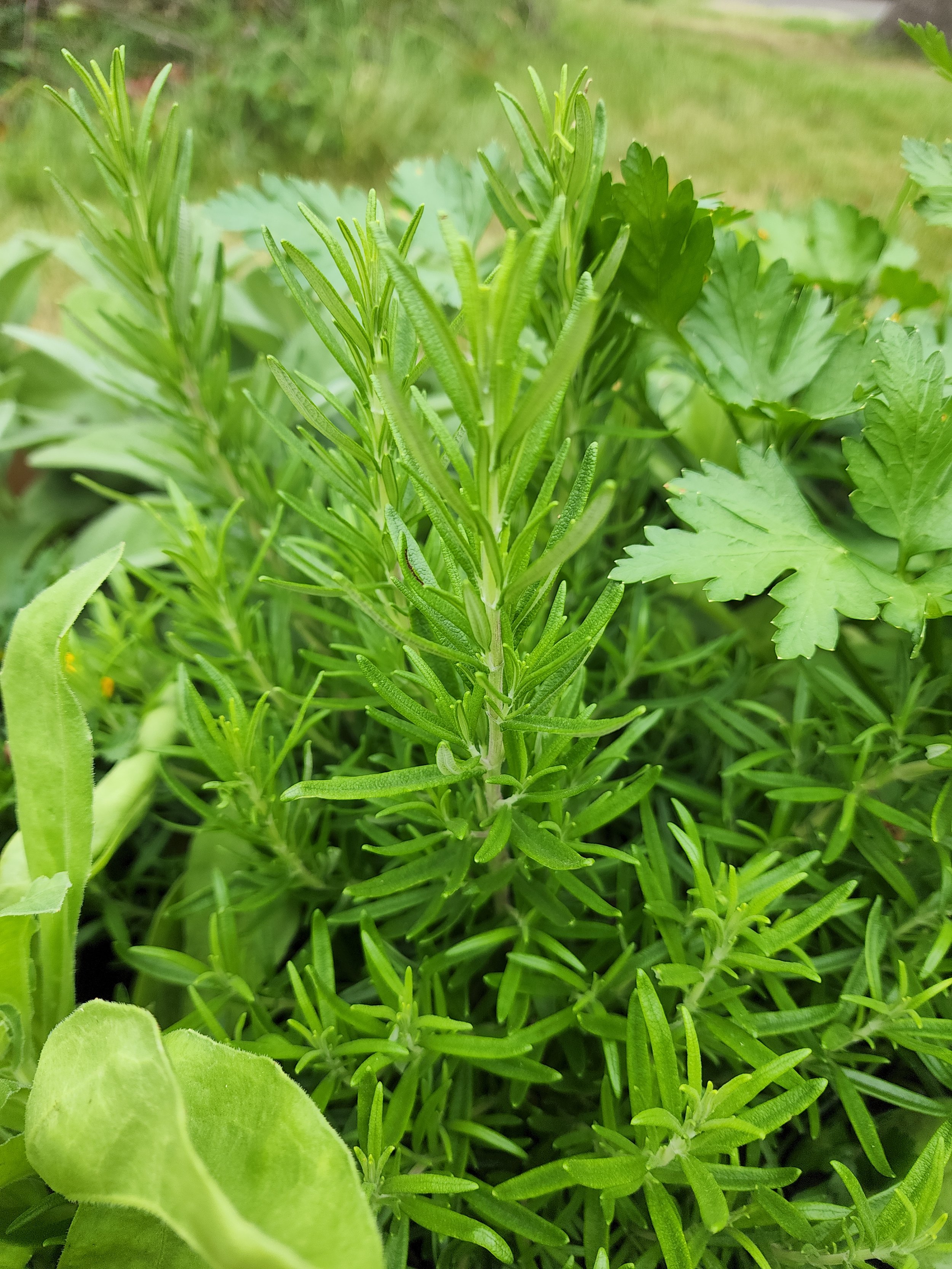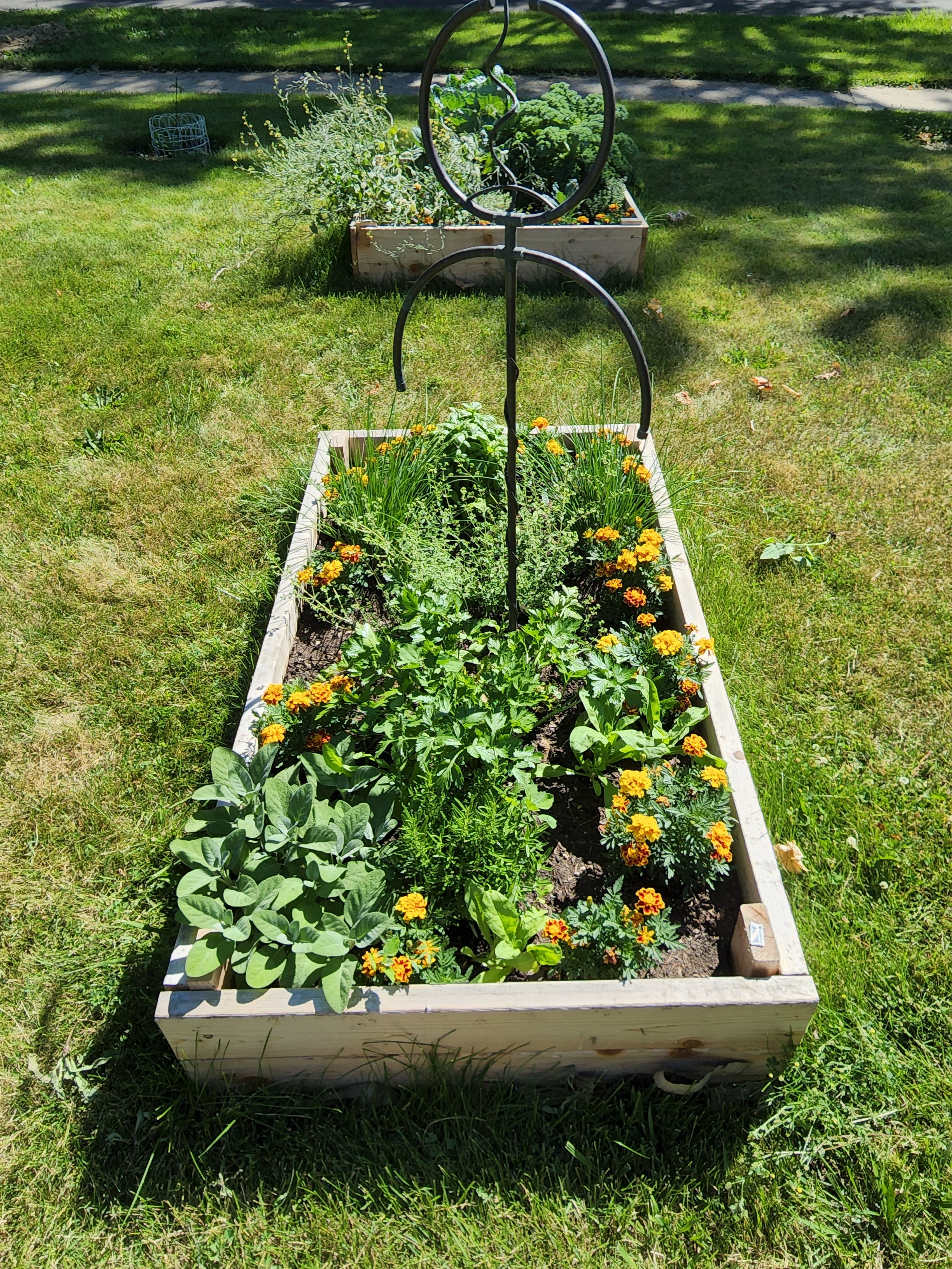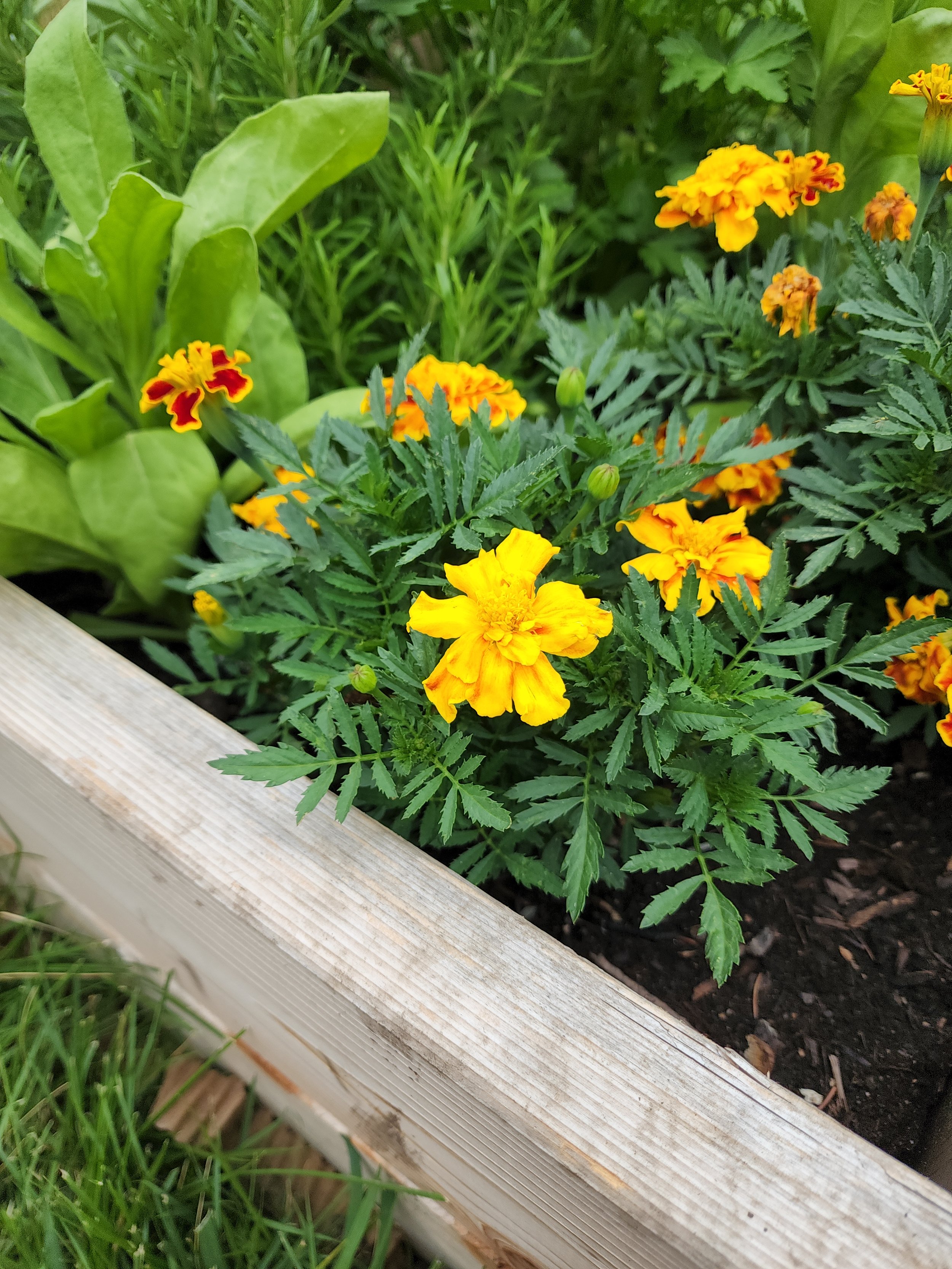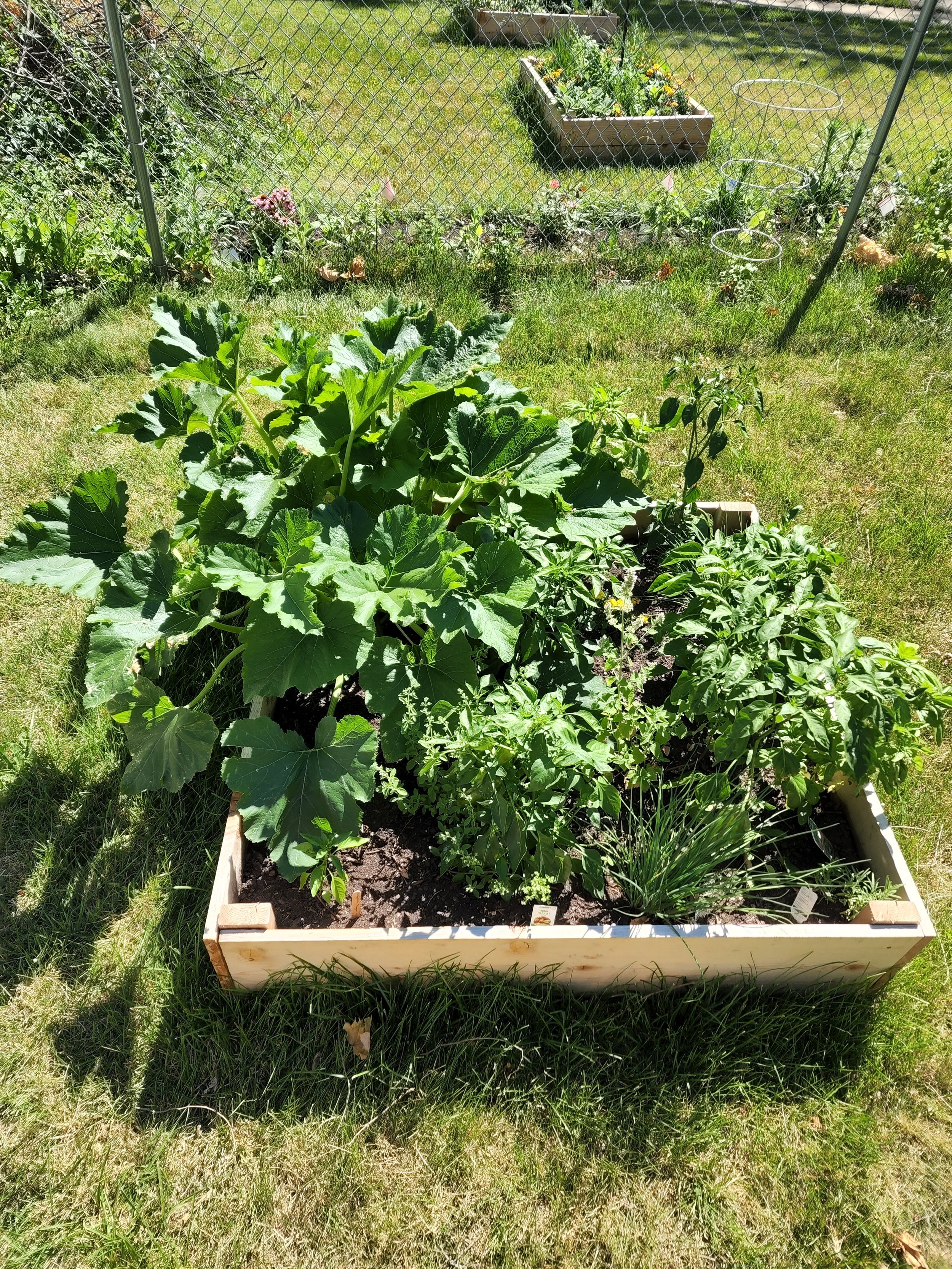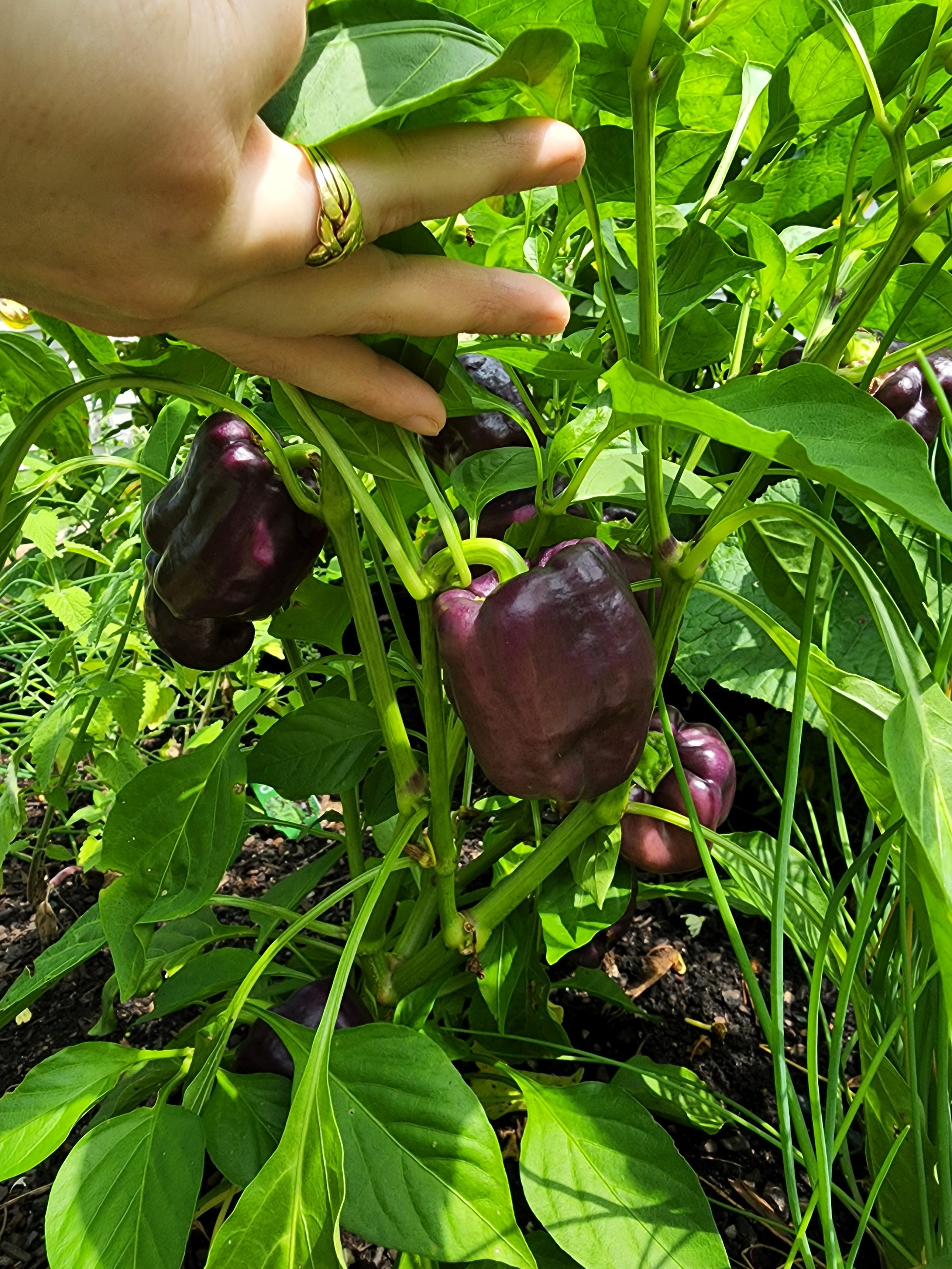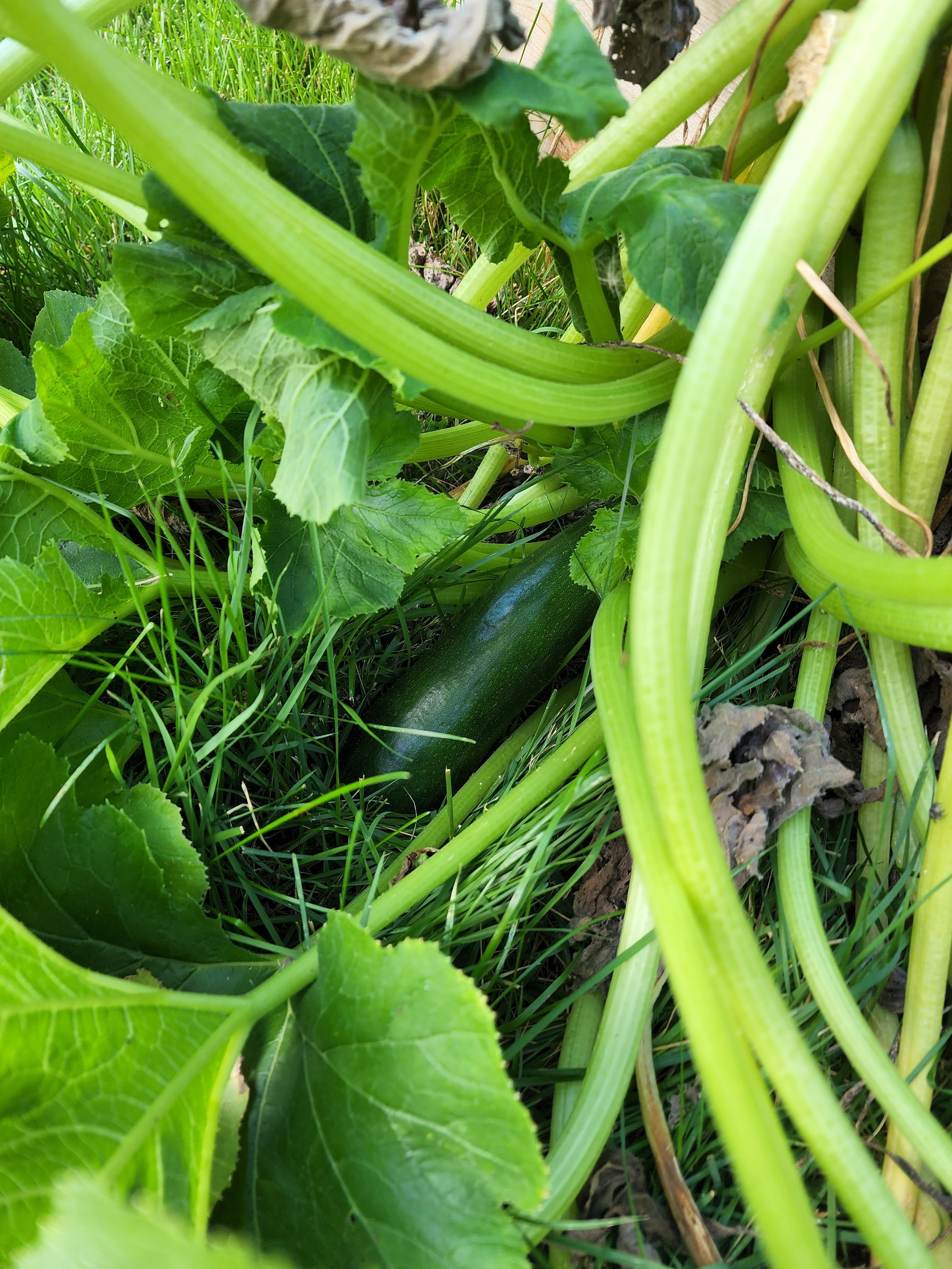Hey everyone! When I’m not working or taking pictures, I’m usually gardening in some form. I’m going to post more pictures of the garden, past and present, as I work on it, as well as write about gardening to collect my thoughts and plan for the future.
I got really into gardening in 2019. I always loved plants but wasn’t great at keeping them alive. I started off by keeping houseplants, and slowly learned how to combat my black thumb, plant-killing tendencies. My friend and my dad helped me build a 4 ft by 4 ft, 12” tall raised bed out of cedar boards for my birthday in April 2019. (We used 2” x 4” cedar boards.) I was living in a condo at the time, and that was all I had room for in terms of an outdoor gardening space, though I had tons of houseplants inside. The construction of the raised bed took almost half a day due to some errors I made in my plans, but after it was constructed, it was solid. I put off planting anything in that bed due to how busy I was, and in part feeling intimidated by my lack of gardening knowledge, until the first lockdown of 2020 hit. Starting in March 2020, I was out of work, furloughed while my job was effectively closed for almost three straight months. I had no longer had any excuse not to try gardening.
I leaned into gardening as a way to spend time outside and expend some of my anxious energy. I grew Tuscan and Russian curly kale, jalapeno peppers and basil in my raised bed. I also bought large plastic planters to grow bigger plants that wouldn’t fit in the raised bed. The only downside was that the condo didn’t have a water hookup outside, so I couldn’t use a hose to water the plants, only a plastic 5-gallon watering can, with many trips in and out through the kitchen’s sliding screen door.
The raised bed that started it all. 2020
The experience went so well and I loved it so much that I decided to buy LED grow bulbs and start some plants inside when it got too cold to garden outside. In zone 5, where I live, the last frost date is roughly in the middle of May, with the first frost date in October. A medium length growing season is nice, but extending it is even better. The second lockdown started in November 2020 and further encouraged my desire to garden indoors. it provided a beacon of joy through the cold winter months. My gardening inside experiments didn’t go quite as planned though. I used clamp lights, which have their strengths but also some serious limitations. Inspired by Rose Apothecary’s plants staged on a ladder with horizontal shelves in Schitt’s Creek, I thought I could get away with gardening via a ladder shelf. I definitely underestimated the amount of vertical space I needed for plants to grow. Despite the ladder being 12 feet tall and almost grazing the ceiling, there wasn’t much space between the rungs for plants’ vertical growth. I also underestimated my cat Spicy’s curiosity and appetite for destruction. She climbed the ladder’s rungs and got into everything, knocking things off and unbalancing the unsecured shelves in an attempt to get to the highest, tallest spot in the condo, a natural cat instinct. I eventually figured out I needed more space, a different form of light and a way to keep my curious kitty from killing my seedlings.
In early 2021, after a lot of research and inspiration from other houseplant lovers online, I found a tall wire shelf with castors. It would give me almost 7 feet of height to work with, it was the perfect width for my space, it had shelves close to the floor for storage, and it would give me lots of room to have plants and start seeds in trays or cells. It would also allow me to customize the distance between each shelf, with room for me to hang, then raise or lower LED grow lights. (I did make do with the clamp lights for a few months, but there were gaps in the bulbs’ coverage due to the angle they were at versus being hung from directly above the plants, and the plants grew at an angle toward the angled clamp lights, rather than straight up as they should.) I added some LED lights from Spider Farmer hung from above a few months later. Spicy continued to be interested in the plants, and continued to climb the shelves, knocking seedlings to the floor and destroying everything in her path. It took careful planning, and a lot of plastic mesh meant to protect fruit trees from birds, to keep her away from the shelf. (For some reason, the bird mesh still attracts her. She likes chewing on it. These days, I’ll catch her sitting next to the shelf, chewing on the edge of the mesh, happy as can be, and 90 percent less interested in the demise of my plants.) The other nice thing about this shelf is it’s easy to disassemble and reassemble, if, for instance, it doesn’t fit through the doorway to the new room you designated as your plant room / solarium. (An important detail I was grateful for when we moved to the new house.)
Cat tax. Spicy, the curious kitty in question, investigating the newly constructed wire plant shelves. 2021
The next set of issues arose in the form of bugs. Fungus gnats laid their eggs in the seedlings’ soil, and the larva killed the young plants. (It’s worth noting that adult, established plants don’t usually have as much of an issue with fungus gnats.) All of the pak choi seedlings I started succumbed to the gnat larva. (I didn’t have enough light for them as it was.) The extra water in my seed starting trays also encouraged the larva’s proliferation, leading to more and more adult fungus gnats. I bought a Bacillus Thuringiensis powder to sprinkle on the soil to combat the larva, which I didn’t end up using, and made numerous water “traps” for the adult gnats. (The traps are just a small amount of water in a bowl with a little dish soap and something to attract them, like a teaspoon of apple cider vinegar or orange juice. These traps also work well for house flies.) After the gnats were dealt with, the seedlings were able to reach adulthood. Then the spider mites reared their heads. I had four foot tall red currant tomato plants withering, and couldn’t figure out why. I saw webs with tiny white specks on the plants as they died, but after a lot of Googling, I had no luck in identifying the culprit until almost a year later. The spider mites killed all of my tomatoes, but left a couple basil, golden Greek pepperoncini and jalapeno seedlings alive for me to transplant outside in the spring. (I still have problems with the spider mites in my houseplants. sigh)
Poor, dead tomatoes. 2021
In the spring of 2021, I decided to try growing young herbs on a little table on my tiny patio, and added a young cucumber plant with a trellis to my raised bed. The cucumber did really well, though each fruit had a decent amount of seeds, and way more spines than I anticipated. (I think I didn’t know the difference between a pickling cucumber and a slicing cucumber, and this cuke was a pickling cuke. I would have preferred a thinner skinned cucumber with less noticeable seeds, similar to a hot house cucumber you would find at the grocery store, which would probably be some version of a slicer cuke.) The herbs didn’t do amazingly well, though they did survive until frost killed them. I’m sure they would have been happier in larger containers or in-ground in another raised bed, but as it was, the 4 foot by 4 foot raised bed was pretty full, especially after the cucumber completely covered the trellis and then grew more vines to overtake the rest of the bed. Miraculously, the Russian curly kale I planted in spring 2020 survived the winter’s sustained -15 degree F days under a layer of snow, and it grew truly massive in the spring and summer months, almost 4 feet tall. Planting in late March or early to mid April (if there’s no snow and the temperatures remain above 40 degrees F) seems to work well for me. I grew a bumper crop of cucumbers, enough to give away to my parents and a neighbor at least once a week, sometimes twice a week. I also grew extra basil, kale and jalapenos in varying sized containers. The container plants that did the best had the largest pots, often terra cotta / clay pots. I should have paired water loving plants with plastic pots since they retained moisture better, and clay pots with plants that preferred less water, but I didn’t have enough experience then with container gardening to think that far ahead. I watered everything from a plastic watering can, often before the sun came up to help dry the plants early and deter mold growth, and on really hot days I watered everything again shortly after sunset, when it was cool enough for me to be outside comfortably. I did have some kind of fungus attack my Tuscan kale plant and kill it in late summer or early fall. The Russian curly kale seemed blessedly unaffected, surprising me yet again.
Afflicted tuscan (lacinato) kale. 2020
In the fall of 2021, when my husband and I bought a house on a corner lot with lots of yard space, I knew I was going to devote a lot of time and money to gardening like nobody’s business the following spring. Blessedly, the house had an outdoor water hookup, so I could water everything with a hose, although the distance from the water spigot to the furthest bed required a 100 foot hose. It isn’t easy to lug around, but for now, it works. (Or until I invest in / install cohesive drip irrigation.) I bought more cedar boards and built three raised beds from April to May 2022, followed by a fourth in the beginning of June. Three of the raised beds were 4 feet by 4 feet, and one was 3 feet by 5 feet to make it easier to reach the middle of the bed. (When I build more raised beds this spring, I’m going to make them the 3 foot by 5 foot size. It made things so much easier, from weeding the beds to picking produce and planting.) I was definitely too ambitious and quickly overwhelmed myself with too many things to plant and take care of. It took time for me to figure out a planting and watering routine. I also didn’t have a plan and got stuck and paralyzed by indecision every time I tried to make even a rudimentary garden plan, so I mostly Googled companion planting as I went along to make sure I wasn’t planting things together that wouldn’t benefit each other. I also had to contend with squirrels eating my young plants. I initially planted two different kinds of young broccoli with nothing around them, only for squirrels to eat them down to the roots. The broccoli didn’t recover or regrow. Squirrels did the same thing with a young Tuscan kale plant, but the plant was resilient enough that luckily it regrew, though its growth was delayed compared to a Russian curly kale planted at the same time. After that, I learned about companion planting to deter pests like squirrels as well as unwanted bugs that could eat my plants. My local Home Depot had marigolds and chives on sale, so I bought some and planted them everywhere I could in borders around the outside edge of each bed. Both worked great for pest control, as did other herbs like oregano, basil, parsley, rosemary and English, German and lemon thyme.
I dedicated one raised bed to mostly brassicas, specifically brussels sprouts, Tuscan kale, Russian curly kale and pak choi. Everything did really well except the pak choi, which bolted early as soon as temperatures hit 70 or 80 degrees F. If I grow pak choi again, it needs to be an early spring or fall crop, because the summers are just too hot and sunny here for it to do well. I bordered the brassica bed with marigolds, calendula and English, German and lemon thyme, as the thyme would be perennial, and the marigolds, calendula and thyme would be good companion plants and deter any brassica’s predatory bugs. All the brassicas (minus the pak choi) were still going strong well into December. Even the thyme was still very happy growing close to the ground in November. As an annual, the calendula died back after it bloomed, before the frost. The brussels sprout plant ended up being 4 or 5 feet tall! I was really impressed as it was my first time growing brussels sprouts of any kind. The Russian curly kale grew to 3 feet tall, with a central stem as thick as my wrist.
The second raised bed (the one that started out with broccoli) ended up as an herb bed, with marigolds and chives in the border, and some calendula that I forgot I sprinkled in as seeds. The orange calendula flowers were a lovely contrast against the lush greens of the herbs. Aside from oregano, basil, parsley and rosemary, the herb bed also had sage. Everything in this bed did well. I even got a black swallowtail caterpillar visitor on the parsley, which I was so excited to find. (I yelled when I saw it! My parents didn’t know what was going on and thought something was wrong.) The herb raised bed looked and smelled so good every time I walked past it. Next growing season, I need to do a better job of using the herbs while they’re fresh, and drying them at the end of the season for use into the winter and spring.
The next raised bed was going to be just a pepper bed, with some herbs mixed in, but I ended up planting a Black Beauty zucchini in one corner. Adding the zucchini was a mistake because it was very happy, got huge and ended up overtaking and shading a lot of the nearby pepper plants, like the shishito and serrano peppers. I had an Ancho poblano pepper, a jalapeno, a purple bell pepper, a candy cane variegated bell pepper and a serrano pepper, interplanted with oregano, catnip, basil and chive companion plants. All the peppers produced at least one or two rounds of fruit, sometimes even a third, with the shishito being the only exception. (It was planted in June and didn’t get a ton of time to grow.) The zucchini was a voracious, consistent producer. I was worried about it having issues with powdery mildew or other fungi, but its true downfall was in squash vine borers and squash bugs. I had no experience with either of these pests as it was my first season growing zucchini, but wow, they totally destroyed it by August. I either have to grow companion plants that deter these bugs, or grow a zucchini variety that’s resistant to them in the future. I should also plant any future zucchini in their own bed, as even one plant gets enormous. **Because the peppers died the moment there was any cold, and I didn’t have any other empty bed, I planted elephant garlic from Gurney’s and Metechi hardneck garlic from MIgardener, so the former pepper bed is now a garlic bed. I’m going to build another bed for peppers near the existing beds in the spring.
Squash bug nymphs, 2022
The last raised bed was a mishmash of a couple different things. I had a suhyo cucumber that did very well and produced fruit nicely, a dill plant, lovage, Mexican tarragon that was very happy (but was way too anise-y for my taste or uses), chervil that died at the first hint of summer’s heat (I never even got to taste it!), a butternut squash plant I planted too late in June or July (that also probably succumbed to bugs) that started to fruit and then died at the first fall frost, Roma and san Marzano tomatoes I planted too late, a cheery yellow / orange honeycomb hybrid cherry tomato my friend Jamie grew from seed and kindly gave me that did amazingly well and produced like crazy, and a bush bean that did well but I couldn’t reach because I planted it in the middle of the 4 foot by 4 foot bed. (Oh well. You live and learn, right?) If I plant bush beans again, they have to A) be at the edge of a bed because they’re shorter than everything else growing there, and everything else will crowd them out, and B) be supported by a short tomato cage, because without that, they just grow outward on the ground instead of upright, which splits the stems and makes it even harder to pick the beans. I would absolutely plant the suhyo cucumber again, though I probably have to plant nasturtiums or something to deter the squash bugs since it’s in the squash family. I think it succumbed in August to the bugs. I would also plant the honeycomb cherry tomato again. My parents really enjoyed eating the cherry tomatoes fresh, and while I don’t love fresh tomatoes, I did dry them in the oven twice and they were excellent. I think my friend got them from Gurney’s, but I have seeds leftover, so I can plant them next year, though the plant gets so big it may needs its own bed.
I’m thinking about building at least two, maybe three, more raised beds in the spring. One will be a replacement pepper bed, one may be for zucchini, and maybe one more will be for tomatoes, although I think I can get away with planting the honeycomb cherry tomato on the far side of the cucumber / lovage bed, as long as I don’t try to plant anything else on the same side of the bed.
Next time, I’ll write about the fruit trees, butterfly garden, the rose garden bed, the fence bed, the honeyberry bed, and what else I did to the yard to get it ready for planting, as well as some of the new fruits and veggies I want to try to grow this year and next.


